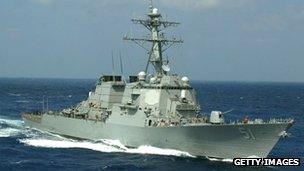Buzz over China's new prototype warship
- Published

China has worked to enhance its naval capability in recent years
Over recent weeks China defence bloggers have been excited by the emergence of pictures of what appears to be a new class of guided missile destroyer for the Chinese Navy.
The hazy pictures on the blogs suggest that one of the vessels - dubbed the PLAN 052D - was launched at the end of last month. At least two others are already under construction.
Chinese warship design tends to evolve gradually. Here the PLAN 052D is no exception - it bears clear links to its predecessor, the 052C.
But it differs in important respects to the extent that many analysts believe what we are seeing is the first of what could be a series of new Chinese warships that could form the backbone of its fleet.
Prof James Holmes, a China-watcher at the US Naval War College, says the chief significance of the new vessel "is that China appears to have settled on a design for a top-of-the-line guided-missile destroyer after a lengthy period of 'fleet experimentation' - a gestation period, if you will".
"The PLA Navy has made a habit of building a couple of copies of each design, taking them to sea, identifying their faults and strengths, and incorporating the lessons learned into future designs," he says.
"Evidently Beijing is satisfied it has learned enough to go into mass production, if indeed," as he believes, "10 hulls are under construction."
"One hopes it will finally settle the debate about the direction and permanence of Chinese naval power," he adds.
There are strong indications, he argues, that the Chinese "believe they've found their standard surface combatant."
This new destroyer could be a central element of Beijing's new blue-water navy.
'Upgraded weapon'
Another observer of Chinese naval affairs is Feng Cao. It was his blogging, external that first alerted Western defence circles to the new warship design.
He has been making a careful study of Chinese defence publications and displays at trade exhibitions for several years, piecing together clues to the way in which China's naval power is developing.
He is not so sure that the 052D is itself the new vessel. But he explained that it was an important step towards what the Chinese Navy has wanted for years; a capable guided-missile destroyer somewhere in size between the US Navy's Arleigh Burke and Ticonderoga classes.

Lanzhou is one of China's serving 052C destroyers
"In a couple of years, we will see a whole new class of surface warship that uses a new propulsion system," he says.
"From the 052C to the 052D, the hull itself really didn't change that much other than moving a couple of things around to fit the new weapon systems and decreasing the radar signature of the ship a little bit. The propulsion system is basically still the same."
"What's really changed is the weapons system," he says. "The first obvious change are the new larger and flat multi-functional radar panels and the new vertical launch system (VLS).
"They are no longer using the VLS we saw on 052C, but rather a new type of universal VLS that can support different types of missiles to strike at both air and sea targets as well as against shore installations."
In his view the 052D is "a stepping stone to that new series of surface warship they want to get to. 052D basically uses an existing proven hull and propulsion system to test out these new weapon systems."
"When the new series of ships come along," he says, "they will have less risks to worry about, because much of the weapon systems will already have their issues worked out using the 052D."
James Holmes stresses the significant leap in capability that these new vessels will bring. The United States' equivalent ships are fitted with the so-called Aegis radar and battle-management system.
If, as he believes, this is an Aegis equivalent ship and there are plans to build 10 of them, then he says "this will give China's navy an air-defence capability on par with that of any navy in the region, and far more hulls than any other Asian fleet."
"Japan and South Korea have Aegis vessels, but only six and three, respectively," he says.
US counterpart
Prof Holmes says the new Chinese vessel's closest US counterpart is probably the US Arleigh Burke-class destroyers, its first Aegis ships.

The new Chinese vessel is said to resemble the USS Arleigh Burke in design
Though he notes that the new Chinese destroyer "carries only two-thirds the complement of missile launchers, so the US ships would have the edge in a one-on-one engagement".
His guess, he says, "in the absence of any hard evidence", "is that the Type 052D is on par with older US Aegis vessels. This is the big unknown, and I would encourage no one to make policy or strategy based on my guesswork!"
James Holmes stresses that the modus operandi of the Chinese navy must also be taken into account when assessing the impact these new ships might have. The 052D may be an inferior vessel to its US counterparts, but it will not be operating alone.
"Let's keep in mind that China operates its fleet almost entirely within range of shore-based anti-ship missiles, fighter aircraft, and ships like patrol craft and submarines."
"These provide protective cover for the surface fleet and, Beijing believes (and I agree), that this is the great equaliser."
"Why go to the effort and expense of building a mirror image of the US Navy if you can hammer away from shore? In short, China doesn't need a fleet symmetrical to the US Navy to fight on ground of its own choosing, namely the China seas and Western Pacific."
- Published6 September 2012
- Published12 May 2012
- Published4 March 2012
- Published18 January 2012
- Published8 June 2011